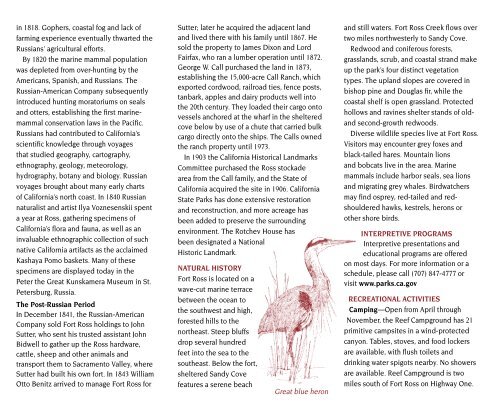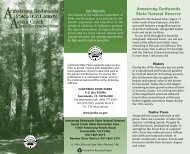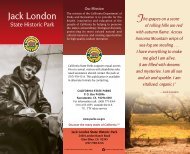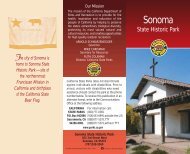Download the Official Fort Ross State Historic Park Map/Brochure
Download the Official Fort Ross State Historic Park Map/Brochure
Download the Official Fort Ross State Historic Park Map/Brochure
You also want an ePaper? Increase the reach of your titles
YUMPU automatically turns print PDFs into web optimized ePapers that Google loves.
in 1818. Gophers, coastal fog and lack of<br />
farming experience eventually thwarted <strong>the</strong><br />
Russians’ agricultural efforts.<br />
By 1820 <strong>the</strong> marine mammal population<br />
was depleted from over-hunting by <strong>the</strong><br />
Americans, Spanish, and Russians. The<br />
Russian-American Company subsequently<br />
introduced hunting moratoriums on seals<br />
and otters, establishing <strong>the</strong> first marinemammal<br />
conservation laws in <strong>the</strong> Pacific.<br />
Russians had contributed to California’s<br />
scientific knowledge through voyages<br />
that studied geography, cartography,<br />
ethnography, geology, meteorology,<br />
hydrography, botany and biology. Russian<br />
voyages brought about many early charts<br />
of California’s north coast. In 1840 Russian<br />
naturalist and artist Ilya Voznesenskii spent<br />
a year at <strong>Ross</strong>, ga<strong>the</strong>ring specimens of<br />
California’s flora and fauna, as well as an<br />
invaluable ethnographic collection of such<br />
native California artifacts as <strong>the</strong> acclaimed<br />
Kashaya Pomo baskets. Many of <strong>the</strong>se<br />
specimens are displayed today in <strong>the</strong><br />
Peter <strong>the</strong> Great Kunskamera Museum in St.<br />
Petersburg, Russia.<br />
The Post-Russian Period<br />
In December 1841, <strong>the</strong> Russian-American<br />
Company sold <strong>Fort</strong> <strong>Ross</strong> holdings to John<br />
Sutter, who sent his trusted assistant John<br />
Bidwell to ga<strong>the</strong>r up <strong>the</strong> <strong>Ross</strong> hardware,<br />
cattle, sheep and o<strong>the</strong>r animals and<br />
transport <strong>the</strong>m to Sacramento Valley, where<br />
Sutter had built his own fort. In 1843 William<br />
Otto Benitz arrived to manage <strong>Fort</strong> <strong>Ross</strong> for<br />
Sutter; later he acquired <strong>the</strong> adjacent land<br />
and lived <strong>the</strong>re with his family until 1867. He<br />
sold <strong>the</strong> property to James Dixon and Lord<br />
Fairfax, who ran a lumber operation until 1872.<br />
George W. Call purchased <strong>the</strong> land in 1873,<br />
establishing <strong>the</strong> 15,000-acre Call Ranch, which<br />
exported cordwood, railroad ties, fence posts,<br />
tanbark, apples and dairy products well into<br />
<strong>the</strong> 20th century. They loaded <strong>the</strong>ir cargo onto<br />
vessels anchored at <strong>the</strong> wharf in <strong>the</strong> sheltered<br />
cove below by use of a chute that carried bulk<br />
cargo directly onto <strong>the</strong> ships. The Calls owned<br />
<strong>the</strong> ranch property until 1973.<br />
In 1903 <strong>the</strong> California <strong>Historic</strong>al Landmarks<br />
Committee purchased <strong>the</strong> <strong>Ross</strong> stockade<br />
area from <strong>the</strong> Call family, and <strong>the</strong> <strong>State</strong> of<br />
California acquired <strong>the</strong> site in 1906. California<br />
<strong>State</strong> <strong>Park</strong>s has done extensive restoration<br />
and reconstruction, and more acreage has<br />
been added to preserve <strong>the</strong> surrounding<br />
environment. The Rotchev House has<br />
been designated a National<br />
<strong>Historic</strong> Landmark.<br />
NATURAL HISTORY<br />
<strong>Fort</strong> <strong>Ross</strong> is located on a<br />
wave-cut marine terrace<br />
between <strong>the</strong> ocean to<br />
<strong>the</strong> southwest and high,<br />
forested hills to <strong>the</strong><br />
nor<strong>the</strong>ast. Steep bluffs<br />
drop several hundred<br />
feet into <strong>the</strong> sea to <strong>the</strong><br />
sou<strong>the</strong>ast. Below <strong>the</strong> fort,<br />
sheltered Sandy Cove<br />
features a serene beach<br />
Great blue heron<br />
and still waters. <strong>Fort</strong> <strong>Ross</strong> Creek flows over<br />
two miles northwesterly to Sandy Cove.<br />
Redwood and coniferous forests,<br />
grasslands, scrub, and coastal strand make<br />
up <strong>the</strong> park’s four distinct vegetation<br />
types. The upland slopes are covered in<br />
bishop pine and Douglas fir, while <strong>the</strong><br />
coastal shelf is open grassland. Protected<br />
hollows and ravines shelter stands of oldand<br />
second-growth redwoods.<br />
Diverse wildlife species live at <strong>Fort</strong> <strong>Ross</strong>.<br />
Visitors may encounter grey foxes and<br />
black-tailed hares. Mountain lions<br />
and bobcats live in <strong>the</strong> area. Marine<br />
m ammals include harbor seals, sea lions<br />
and m igrating grey whales. Birdwatchers<br />
may find osprey, r ed-tailed and redshouldered<br />
hawks, kestrels, herons or<br />
o<strong>the</strong>r shore birds.<br />
Interpretive PROgrams<br />
Interpretive presentations and<br />
educational programs are offered<br />
on most days. For more information or a<br />
schedule, please call (707) 847-4777 or<br />
visit www.parks.ca.gov<br />
RECREATIONAL ACTIVITIES<br />
Camping—Open from April through<br />
November, <strong>the</strong> Reef C ampground has 21<br />
primitive campsites in a wind-protected<br />
canyon. Tables, stoves, and food lockers<br />
are available, with flush toilets and<br />
drinking water spigots nearby. No showers<br />
are available. Reef Campground is two<br />
miles south of <strong>Fort</strong> <strong>Ross</strong> on Highway One.






